There’s a phenomenon this summer where bad weather is tailing the England cricket team as it bounces between Manchester and Southampton.
We are near the former and whenever there hasn’t been cricket, the harsh Mancunian sun has been baking the turf to concrete. We are currently experiencing – and really, there is no other word for it – perfect weather. Conversely, at the Whatever-You’re-Supposed-To-Call-It Bowl in Hampshire, it appears to be autumn.
We have every confidence the scenario will reverse for the T20 internationals at Old Trafford later in the month because that’s the way things have been going. We actually have a theory that one of the England players is a rain god, like Rob McKenna.
As well as being massively annoying, the ongoing inclement weather has also raised some important questions about safety.
Midway through day two, Sky Sports did a whole big thing about captaincy with Mike Atherton, Nasser Hussain and Shane Warne. The rain which had stopped play had relented, but it was still very murky, and yet the three of them sat outside in the stand where any one of them could have easily sustained a fearful blow in the substandard light conditions.
As a measure of how dark it was, look at poor Shane crinkling his plasticised face into an actual squint in a forlorn bid to make anything out.

And look at poor Nasser who clearly had *no idea* that he had blindly grabbed and donned a shirt, V-necked jumper and blazer combination.
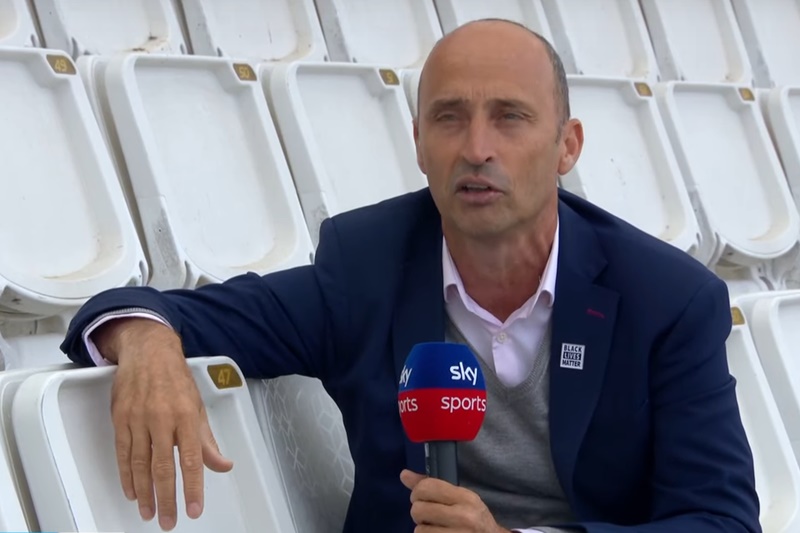
You have to remember that the cameras enhance the light. In those conditions Nasser was grimly oblivious to his absolute car crash attire.
And then look at Athers.
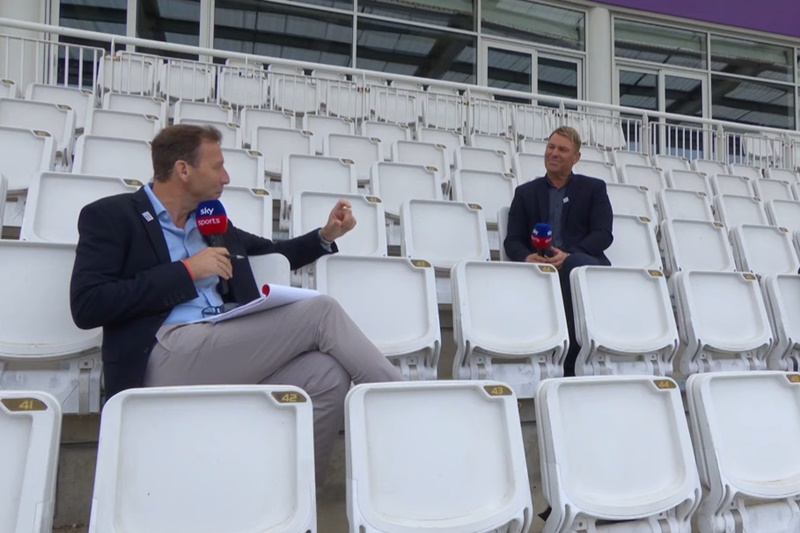
Athers had notes on actual 20th Century paper, instead of a phone or tablet or whatever.
That means his words weren’t illuminated. What if in trying to read them in the grim light, he’d accidentally said “Pricky Ponting” or “Alastair Cock”? He’d have been out of a job, wouldn’t he?
Is it really fair to force Michael Atherton to try and read players’ names in wholly unsatisfactory light?
He was also holding a pen, which could definitely have had someone’s massively-dilated eye out.
It’s all well and good trying to entertain the fans, but should commentators really be asked to face difficult questions about persuading Andrew Flintoff to take fielding practice seriously when their safety is genuinely at risk?

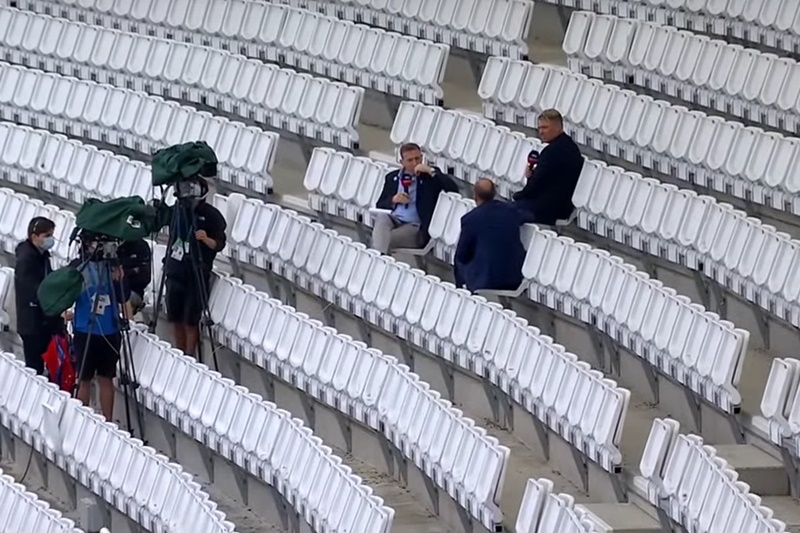
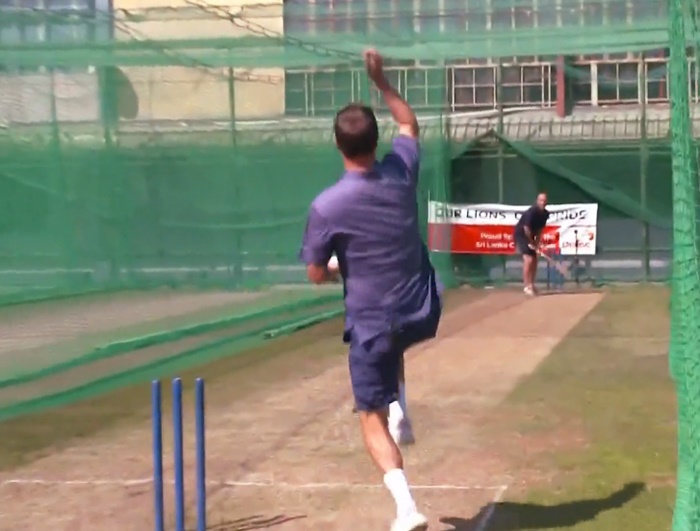
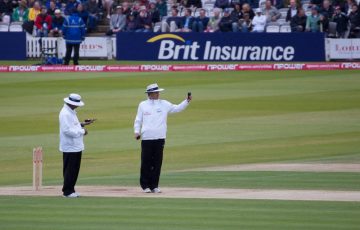

I can confirm, it has been sweltering in Manchester. Southampton should now take over as the butt of all jokes about rain for the next decade or so.
At least it stopped Mikey Holding going on and on about umpire’s calls for LBW. I like him lots, but he really needs to let it go.
I’ve always liked Holding, but he seems to be drifting in the the realm of an old person who keeps banging on about the same old shit, day in – day out, to the point of complete boredom. It was a method of commentary invented by Geoff (they used to bowl 160 overs an hour in my day) Boycott.
Did anyone see the really interesting Debate show hosted by Mark Butcher on Friday night? They started off with the question of how to avoid bad light interrupting play. Cork & Croft (Robert not Colin) came up with the idea of bigger lights. This is obvious really, I mean the sun works really well in Manchester and Sol is 93m miles away from the Trafford Centre (the geospatial location from which they base all solar measurements). Now, cricket lighting expert Brian Cox estimates that when Sol has got his hat on the Trafford Centre is illuminated by an effective 6840000000000000000000000000 lumens, which seems fine. This actually equates to 10,000 lumens per 300mm sq of surface area of Earth’s sun. Now the sums start getting easier. Say each lighting module is roughly a foot square and the lighting matrix is made up of 10 x 10 cluster at each corner of the oval (obviously I mean where the clothoid transitions into the arc) this means that the standard southern cricket ground has approximately 400 individual lamps.
Anyhow, given the fact we only ever see half of the sun at any given time in the North West we can divide the required surface area required for lamps with an effective output of 10,000 lumens by 2 giving us a meagre (6.088 x 10^12 km) / 2 == 3,044,000,000,000 sq km. This still seems like quite a lot, so I did extensive research on the degradation of radiation and light through 93 million miles of basically fuck all, and a bit of ionosphere and some other of Earth’s atmospherics and came up with a factor of exactly 4. Who’d have thought it? It’s like the time I read my first science book ‘The Da Vinci Code’ and realised the PHI wasn’t just a misspelling of PI.
Okey dokey, the exact surface area of lighting matrices required to recreate Manchester’s level of natural light in the south of England is 3,044,000,000,000 sq km / 4 == 761,000,000,000 sq km. Now this is still quite a big number, but then I realised that there’s 4 lighting columns at most grounds (y’see that number 4 has cropped up again!). So each column needs a lighting surface area of 761,000,000,000 sq km / 4 which equates to only 190,250,000,000 km sq per column. This will involve building lighting clusters which are 436176 and a bit km square, which obviously has implications with the moon’s orbit of the Earth, but I’m sure the ICC can come up with a solution to that.
You can’t argue with science.
Wouldn’t know where to start.
The main thing I’ve taken away from that is that there doesn’t appear to be a character limit on comments.
Didn’t mean to sound like a twat, but when they ask Dominic Cork how to combat bad light stopping play and he answers make bigger lights…something something pink ball I get really frustrated.
It’s a game of fucking cricket. Bad light has been stopping play ever since I’ve been listening to it / watching it.
If there is danger to the players or umpires then they must be brought off the field of play. It’s really not that important.
I think it’s a minor miracle batsmen can hit the ball in dark light – even when light is good, the time it takes your eyes and then brain to process what you’re seeing means that the ball has already moved a few feet from the position it was in the image you’re processing, but part of your brain somehow compensates for the motion and tells you the ball is further along the trajectory right now than you actually “saw”. See https://www.salk.edu/news-release/we-live-in-the-past-and-our-brain-makes-up-for-it/
In dark light the time lag gets even worse because there are fewer photons buzzing about and you can need multiple “hits” to trigger the receptor cells in your retina. In fact our visual perception of how bright/dark it is can be pretty skewed because of how well we adapt to the change, so what we perceive as only a slight change in light levels (eg indoors vs outdoors on a sunny day) would seem like a much bigger change if you checked with a light meter. Though I’m not sure even the most overenthusiastic umpire would wield the instrument indoors at home. Nevertheless, “murky” light is indeed a lot darker than a bright cloudless day and the time lag phenomenon in vision is more severe.
You can observe how much visual delay is caused by a reduction in by levels by the Pulfrich Effect (https://en.wikipedia.org/wiki/Pulfrich_effect) that occurs when you cover one of your eyes with a dark filter (or set of sunglasses etc) and the way your eyes now get out of sync causes side-to-side movement to appear to be moving towards or away from you. This optical illusion was the basis for those “3D” episodes of Doctor Who you could see with special/stupid glasses in the nineties… Though I believe Pulfrich never saw the effect by virtue of being blind in one eye.
You can even measure the time delay caused by the additional light reduction by watching a pendulum swing side to side while wearing those daft glasses (not the red and green ones, that’s a different effect) or putting sunglasses over one eye (which is probably even more daft) and watching the pendulum appear to move around tracing an oval shape over your floor (and reversing which eye is “dark” switches the apparent motion between clockwise and anticlockwise). By measuring the distance the pendulum appears to be moving forward/back out of its plane, it’s possible to do some simple calculations to figure out the time delay between your eyes (https://www.open.edu/openlearn/science-maths-technology/science/across-the-sciences/measure-the-pulfrich-effect ). If I remember half-accurately the time-lag difference the “bad light” side of your vision makes is in the order of magnitude of hundredths of a second, which is time enough for a cricket ball to travel some. How much this affects safety I’m not sure but clearly it will be harder for batters to hit (or dodge) and fielders to catch a ball in bad light, and I would be even more anti-keen than usual to be in any fielding position whose name starts with “silly”.
You wrote this piece knowing it was going to be a geeks’ charter and also knowing that the relentless lack of cricket (mostly for wet rather than dark reasons it must be said) would provide geeks with an opportunity to write copiously.
The comments on this piece are a testament to that policy decision of yours, KC.
I used the unexpected down time to complete a set of accounts and tax return, submitting said geeky documents to the relevant official channels for scrutiny.
I also wrote a tribute to Gerry Goddin; yet another of my comedy friends from the 1990s who has died. That’s three this year – it is getting beyond a joke. It has nothing whatever to do with cricket, but it is a strange tale and might help some fill those unexpected serendipitous minutes/hours:
http://ianlouisharris.com/2020/08/10/remembering-gerry-goddin-comedy-writer-man-of-mystery-who-died-10-august-2020/
As for the science of better lighting for cricket in the murk/dusk/dark…I’ll leave that to those better able tan me to blend science and humour. BERT – WHERE THE HELL ARE YA?
I’m sorry, I’d just come off a night shift and might have been after a subject to entertain me.
Night shift? Surely you could simply have played with a pink ball, Hoopy? :-0
Perhaps in Tests unable to take place due to bad light, teams should be awarded their predicted results instead, as determined by their pundits in consultation with the umpires. Then DRS will run an incomprehensible algorithm on their predictions in order to prevent results inflation. But players and spectators will be allowed to hold demonstrations on the field of play if they disagree with the DRS adjustment, to see if the umpires will return to the original prediction (“umpire’s call”). If everyone still disagrees, there’s a replay in September.
Controversial opinion – if all else failed, I’d rather a Test match be settled by a bowl-out than a Super Over, though both would be ghastly of course (https://en.wikipedia.org/wiki/Bowl-out for the uninitiated). One advantage of a bowl-out is you can still play one in bad light…
In fact maybe maybe when a match has stopped for light alone, teams could play out a friendly bowl-out competition to keep the crowd entertained, on a spare pitch if necessary to spare damage to the one in use. Better than hanging around doing nothing.
Above suggestion might not be intended entirely seriously but this was pretty fun, no?
https:/youtube.com/watch?v=mI_S_8aQTbo
Apologies to all Pakistan fans.
Cover everything in luminescent paint and play at midnight.
NIGHTBALL!
Obviously we’re just thinking of Speedball here, but it definitely sounds like a violent dystopian sport.
In the early 1990s, I recall a fun-packed game of night cricket when at a country retreat with work colleagues. We used car headlights as floodlights.
Many of the details will be lost in the mists of time, but I recall the game well in an impressionistic sense and I’m pretty sure there is a match report worthy of this website in there, once I find the relevant diary entry.
It won’t be a report for everyone – the health and safety brigade will need a trigger warning and really shouldn’t look.
Leave it with me.
Didn’t there used to be some terrible urban night golf thing with light-up balls?
NIGHTGOLF!
I thought the possibly humorously-intended word of the King maybe deceiveth me, but YES ITS NAME IS NIGHTGOLF.
https://www.youtube.com/watch?v=0nv_3aEQef8
Peering at plastic Shane through the gloom, I was wondering why, when he has spent so much on his new hair (“Whatever. Is. Individually. Required. Eh. Warney?”), has he chosen to have it cut and dyed to resemble a cheap toupee?
Daisy has lately been making some unfettered remarks about Shane’s dress sense too, Essie.
“Ridiculous” being one of the kinder and less ripe adjectives.
Specifically, the trousers “à les Rutles”:
https://youtu.be/gB0MxBMMKHM